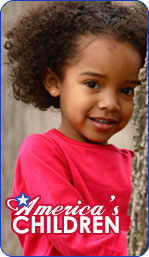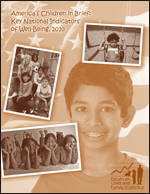Child Well-Being
 Annual report documents the latest Federal statistics in child well-being.
Annual report documents the latest Federal statistics in child well-being.
The report America's Children In Brief: Key National Indicators of Well-Being, 2010 is an annual compendium of 40 key indicators—drawn from the most recent, reliable official statistics—on important aspects of the lives of children and their families. The report is produced by the Federal Interagency Forum on Child and Family Statistics, a working group of 22 Federal agencies (including the National Center for Health Statistics, Centers for Disease Control and Prevention) that collect, analyze, and report data on issues related to children and families. The Forum alternates publishing a more detailed report every other year with a condensed version that highlights selected indicators. This year's report is a brief report and the next full report will be published in July 2011.
For detailed information see ChildStats.gov or use the links below to help you learn more about specific areas of America's children.
- Family and Social Environment is about the composition of children's families and the social environment in which they live.
- Economic Circumstances presents information on the economic resources of children's households and on their food-related well-being.
- Health Care includes information about selected determinants of health care utilization such as health insurance and measures of utilization of health care such as immunizations.
- Physical Environment and Safety presents indicators on how environmental conditions (such as air quality and exposure to lead) may impact children.
- Behavior focuses on illegal and high-risk behaviors such as substance use behaviors, sexual activity, and perpetration of serious violent crime.
- Education presents key indicators of how well children are learning and progressing from early childhood through postsecondary school.
- Healthpresents indicators of several important aspects or determinants of child health such as low birthweight/preterm birth, depression, asthma, and obesity.

From America's Children in Brief:
Key National Indicators of Well-Being, 2010
In 2009, 70 percent of children under age 18 lived with two parents, 26 percent lived with one parent and 4 percent lived with neither parent.
About 22 percent of children lived in food-insecure households in 2008, up from 17 percent in 2007 and the highest recorded percentage.
The percentage of children ages 5-11 with untreated dental cavities declined from 27 percent in 1999-2004 to 20 percent in 2005-2008.
The percentage of infants born preterm declined for the second straight year, from 12.8 percent in 2006 to 12.7 percent in 2007 and to 12.3 percent in 2008.
19% of children ages 6–17 were obese in 2007-2008, compared to 6% in 1976-1980, but unchanged from 2005-2006.
This annual report provides helpful information for families, health professionals, scientists and policy makers in one convenient reference so they can better serve the needs of children and their families.
Order a copy of America's Children in Brief: Key National Indicators of Well-Being, 2010.
Get email updates
To receive email updates about this page, enter your email address:
Contact Us:
- Centers for Disease Control and Prevention
1600 Clifton Rd
Atlanta, GA 30333 - 800-CDC-INFO
(800-232-4636)
TTY: (888) 232-6348 - Contact CDC-INFO




